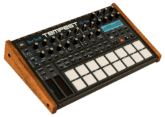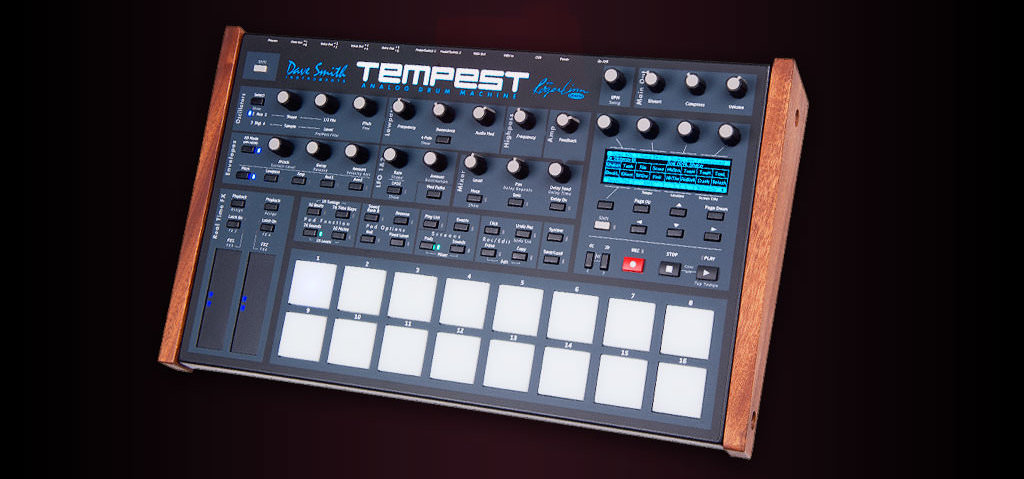Tempest architecture
 In contrast to almost all of its rivals, the Tempest doesn’t limit each of its voices to a particular type of drum. All six voices are identical, and therefore equally as versatile. The sound engine is effectively closer to a monosynth than to most traditional drum machine circuits. In fact, the voices offer so many options that we’d be here all day if we tried to describe the full architecture.
In contrast to almost all of its rivals, the Tempest doesn’t limit each of its voices to a particular type of drum. All six voices are identical, and therefore equally as versatile. The sound engine is effectively closer to a monosynth than to most traditional drum machine circuits. In fact, the voices offer so many options that we’d be here all day if we tried to describe the full architecture.
In summary, each voice is based around two analogue oscillators and two digital, sample-based oscillators. Five extremely fast envelopes are used to control oscillator pitch, amp level, low-pass filter cutoff, or just about any other parameter via the extensive modulation routing options. This is really just the tip of the iceberg, before we’ve even considered the two LFOs, high-pass filter, cross-modulation options or MIDI-based pseudo-delay effect for each voice. There are even analogue distortion and stereo compression circuits on the master output.
Unprecedented control
It’s a complex setup, but it means you have unprecedented control over your drum hits. What it also means is that you can’t just load a generic default patch, tweak one or two settings and expect it to sound like a kick, clap or hi-hat. Instead, the presets should be considered as starting points for further sound design. The ethos is reiterated by the way the machine uses samples in the digital oscillators: the Tempest can’t sample, and you can’t load your own custom sounds. Instead, the hundreds of sampled hits are intended to be used as starting points for further synthesis rather than simply triggered and played back as-is.
 To say that the Tempest requires some effort to get the best results is an understatement. If you want an immediate, intuitive drum machine with just a small number of user-friendly parameters, buy a DRM1. But you must bear in mind that the range of sounds which can be coaxed from the Tempest is far greater than most of its rivals. The Tempest is capable of everything from vintage-sounding hits (it’ll do pretty convincing impressions of the Roland classics) through to the most contemporary techno aggression. It’s undoubtedly a complex, multi-faceted editing system, but almost all parameters can be accessed and adjusted without the need to refer to the LCD screen. It’s worth noting, too, that the user forum at prophet5.org is a fantastic source of advice on synthesis.
To say that the Tempest requires some effort to get the best results is an understatement. If you want an immediate, intuitive drum machine with just a small number of user-friendly parameters, buy a DRM1. But you must bear in mind that the range of sounds which can be coaxed from the Tempest is far greater than most of its rivals. The Tempest is capable of everything from vintage-sounding hits (it’ll do pretty convincing impressions of the Roland classics) through to the most contemporary techno aggression. It’s undoubtedly a complex, multi-faceted editing system, but almost all parameters can be accessed and adjusted without the need to refer to the LCD screen. It’s worth noting, too, that the user forum at prophet5.org is a fantastic source of advice on synthesis.
More importantly, the sound itself is phenomenal. You might get away with burying a thin, weak synth at the back of a mix, but there’s no hiding place for drums. The Tempest delivers top notch hits before you even consider any external processing. It isn’t foolproof – you can easily dial in a wimpy kick or a flabby snare if you’re not careful – but once you get the hang of the system it’s unrivalled.
Sequencing: for studio or stage?
The Linn-designed MPC sampling workstations set the benchmark for hardware sequencing. In many respects, the Tempest follows suit, albeit with a much greater emphasis on step sequencing and loops rather than long patterns and full song arrangements. The velocity- and aftertouch-sensitive pads are a joy to use, allowing note variations to be programmed with ease whether recording in step time or real time.
 There are areas in which the sequencer could be improved. The absence of a fully unquantised setting for real-time recording is a baffling omission (and one which is high on the agenda for future OS revisions, if user requests on the Tempest forums are anything to go by).
There are areas in which the sequencer could be improved. The absence of a fully unquantised setting for real-time recording is a baffling omission (and one which is high on the agenda for future OS revisions, if user requests on the Tempest forums are anything to go by).
There’s also a sense that the sequencer is slightly more suitable for live performance – setting up a basic pattern then adjusting parameters on the fly using the two excellent ribbon controllers, for example – rather than for complex pre-planned automation in the studio. Whether that’s a problem will depend on your approach to drum programming, but it’s worth bearing in mind if you’re considering the Tempest alongside a more studio-focused alternative such as the Machinedrum.
Conclusion
Hardware drum machines are undoubtedly an expensive, possibly even exclusive, option these days. For most producers, they’re a luxury in comparison to drum sample packs or plugins. So is the Tempest worth it? We think so. It’s certainly not cheap, but it’s a phenomenally versatile machine which sounds incredible. The retail price still isn’t that much more than current second-hand 808 and 909 prices.
The Tempest offers virtually infinite sound design options, a fantastically powerful sequencer and real-time performance features which have already made it a mainstay of numerous live dance acts. Its flexibility means it can truly lend itself to absolutely any type of electronic music.
We’d go so far as to say that the Tempest is the best hardware drum machine currently in production (the only thing which runs it close would be a Machinedrum). It’s exciting also to consider the fact that DSI seem committed to the product’s future development, which means the feature set is likely to evolve in accordance with users’ demands.
Will the Tempest go down in history as a classic? Time will tell, but I believe it will. I’ve bought one, and I’ve sold a couple of my old Roland drum machines to pay for it.
Some of the best Tempest demos from around the web:
The Verdict
Price: $1,999
Purchase: DSI Tempest
The Final Word
Powerful sound and versatile options. A future classic.

05.48 PM
Thank you guys so much for this. I was actually planning on buying this today, and although it still sounds very enticing, you’ve given me the names of some other sequencers to look into. Good lookin’ out.
03.22 PM
great feature! could you perhaps do some passing notes on how to make pure analog drum sounds on it? i find myself using mainly sample drums, but using the analog osc’s for synth sounds.
i can’t wait for them to allow it to sequence other hardware. would also love to be able to set a multiple sounds to recieve midi notes from different channels.
04.30 PM
sorry guys but 5 stars for that machine i don´t know. maybe it sounds great but this thing is like a prototype you still can´t use all functions and the software in it has too many bugs. so i would wait or don´t buy it again.
09.12 PM
How old is this article? It isn’t much more than 808/909 prices?! It’s about a grand (in £’s) less!
01.02 PM
5 years on and Roger has acknowledged that its broken and is fixing it , after 5 years, class action anyone’s?